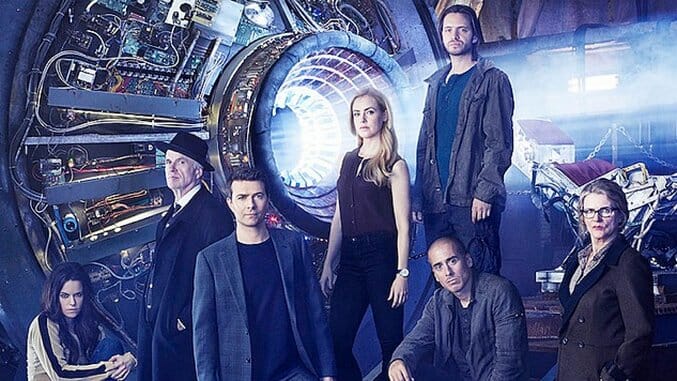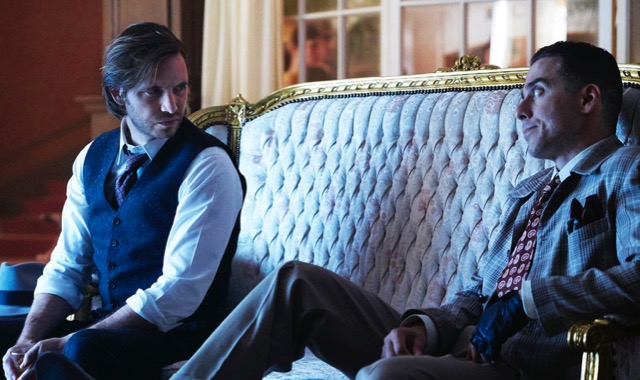John Mott on Designing the Past, Present and Future of 12 Monkeys

The first season of Syfy’s 12 Monkeys kept things simple—well, as “simple” as a show about preventing the apocalypse via time travel can be. For the most part we witnessed traveling between the post-plague future and pre-outbreak present, give or take a few years. But when the show finally made good on an early tease about protagonist James Cole (Aaron Stanford) showing up in the ‘80s by the end of Season One, it was a hint of things to come.
Now, in Season Two, the show’s been ripping through decades like it’s been collecting stamps towards a free sub (and maybe a captain’s hat), jumping back from 2044 to the 1940s, ‘70s, ‘60s, 2016 and 2020, all in an attempt to save the present, the future, and time itself. That’s all great for sci-fi fans, who’ve come to love 12 Monkeys for its time-traveling mind warp and the way it plays with genre conventions.
It’s also a lot more demanding for the people tasked with pulling it all off week in and week out—people like production designer John Mott is no stranger to transporting viewers back to the past. He helped develop The Americans’ signature Cold War-era look in the series’ first and second seasons. But 12 Monkeys’ sets pose an added degree of difficulty. Mott can’t simply focus on one moment in time, he has to keep track as the show pinballs through various decades, often in the course of a single episode. Which is, in a word, “challenging.”
The trick for Mott, whether he’s designing a set for the show’s post-apocalyptic future or its recent past, is to find “some kind of anchor, in terms of time and space.” He says it would be far more difficult to be asked to design something that wasn’t based on any existing architecture, like an alien planet. In Season One, Mott used the exterior of an old power plant in Toronto (where the show films) as inspiration for the show’s underground headquarters in 2044.
This season though, Aaron Sanford’s Cole also has a home base in the past: the Emerson Hotel. A throwback to classic turn-of-the-century elegance, the luxe accommodations are a welcome departure from the show’s grim and gritty post-apocalyptic aesthetic, as much for Mott as it is for Cole. Mott says he modeled the Emerson after many of New York City’s historic hotels, from the Algonquin to the Waldorf Astoria. “One I particularly liked, which is no longer in existence, is the Hotel Astor in New York City,” says Mott.
We first see the Emerson in its 2016 incarnation though, more rundown boarding house than grand old hotel, before traveling back to the 1940s to see it in all its glory, revisiting it again each time Cole’s zapped back. And having a designated constant in the past helped reduce the load on both the production team and the show’s writers, says 12 Monkeys co-creator/showrunner Terry Matalas, sparing them from having to introduce audiences to a brand-new location each week. “Just from a production standpoint, you want a standing set that you can go to on your soundstage all the time, as opposed to the logistics of them having to find a place in each time period,” he explains. Plus, as a bonus, seeing the hotel change over the years is “a great way to demonstrate the passage of time,” Matalas says.
All told, the Emerson set—which includes the double-high foyer and mezzanine, Cole’s suite and the connecting hallways—took about six weeks to build. Or, around the same amount of time it took Mott and his team to create Season One’s big build, the time machine and its accompanying compound.
Mott tells Paste that designing the hotel was equal parts form and function, as much about the logistics of shooting in the space as the look of it. That big, expansive foyer doesn’t just look impressive all done up, it also gives the characters and cameras ample room to maneuver. Hence, the Emerson’s open second level, an unusual design feature for a hotel from that era. “It’s not like no hotels have that. But not many have that combination of the big front with the light coming through the front and the mezzanine,” explains Mott.
“If you have a big set, you want to get up and see down into it, and you want to be able to use it, rather than always looking up from the bottom,” he continues. “In the hotel’s case, you can actually have a scene up there. It’s big enough to have a scene on the mezzanine.”
It also helps save the show money, removing the need for expensive crane shots. “It’s very nice to be able to have sort of pre-existing camera platforms that are not something that you have to bring in every time you want to get the camera up there,” he says. This is not an insignificant consideration on a show that moves around as much as 12 Monkeys does.
